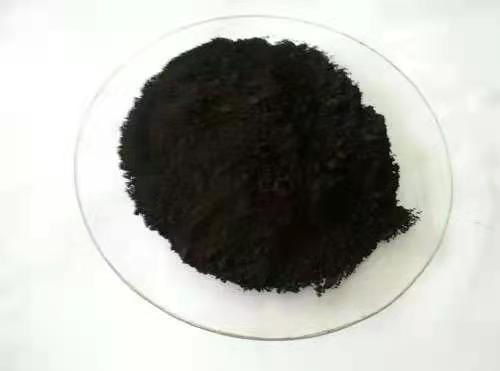Copper oxide is an inorganic substance with the chemical formula CuO. It is a black oxide of copper, slightly amphiphilic and slightly hygroscopic. Insoluble in water, soluble in acid, stable to heat, and decomposes oxygen at high temperature. Copper oxide is mainly used to make rayon, ceramics, glazes, and enamels, batteries, petroleum desulfurizes, pesticides, and also for hydrogen production, catalysts, and green glass.

Laboratory method
1. Use copper salt such as CuSO4 to react with alkali (NaOH) to generate Cu(OH)2, and then heat and decompose Cu(OH)2 to prepare CuO.
CuSO4+ 2NaOH = Cu(OH)2↓ + Na2SO4
Cu(OH)2= CuO + H2O (condition: heating)
One-third suitable mortar: The medicines contained in each grinding should not exceed one-third of the volume of the mortar (the more loaded will not only spill out during grinding but also reduce the fineness and speed of grinding).
Slow first and then fast circular grinding: When grinding, the pestle should be pressed on the mortar body and always make a circular motion. The speed should be slow at the beginning. As the degree of broken medicine increases, the grinding speed can be appropriately increased.
The saturated liquid should be used for caustic soda: In order to reduce the volume of the solution, it is best to use a saturated NaOH solution.
Turn all black and stop: do not stop heating until everything becomes black solid.
2. Copper oxide can be made by heating metallic copper in the air, or by heating and decomposing copper hydroxide, copper nitrate, basic copper carbonate, etc.
2Cu + O2 = 2CuO
2Cu(NO3)2→ 2CuO + 4NO2+ O2 (condition: heating)
Cu(OH)2 ▪CuCO3→ 2CuO + CO2+ H2O (condition: heating)
Industrial Manufacturing Law
1. Copper powder oxidation method
Using copper ash and copper slag as raw materials, it is roasted and heated with coal gas for preliminary oxidation to remove moisture and organic impurities in the raw materials. The generated primary oxide is naturally cooled, and after pulverization, it undergoes secondary oxidation to obtain crude copper oxide. The crude copper oxide is added to a reactor pre-installed with 1:1 sulfuric acid, and the reaction is heated and stirred until the relative density of the liquid is doubled, and the pH value is 2-3 as the end of the reaction, and a copper sulfate solution is generated. After clarification, under heating and stirring conditions, iron shavings are added to replace the copper and then washed with hot water until there is no sulfate and iron. After centrifugal separation, drying, oxidizing, and roasting at 450°C for 8 hours, cooling, crushing to 100 mesh, and then oxidizing in an oxidizing furnace to obtain copper oxide powder.
4Cu + O2→ 2Cu2O
Cu2O + 0.5O2→ 2CuO
CuO + H2SO4→ CuSO4+ H2O
CuSO4+ Fe → FeSO4 + Cu↓
2Cu + O2→ 2CuO
2. Copper nitrate thermal decomposition method
The electrolytic copper is dissolved in dilute nitric acid and evaporated to dryness on a water bath, and then heated in a desiccator from 90°C to 120°C very slowly. When a soft basic salt is formed, it is boiled in water, filtered, and dried; then it is slowly heated to 400°C to remove most of the nitric acid; then crushed and heated to 850°C for 1 hour to decompose into oxidation copper. In order to make the reaction more complete, the product can be pulverized again, heated at about 700°C for 1 hour, and then placed in a desiccator to cool.
3. Copper carbonate thermal decomposition method
Put copper powder or copper wire in a fume hood with as little 6mol/L nitric acid as possible to completely dissolve it. If the solution is opaque, it needs to be filtered. In addition, the sodium carbonate solution is mixed with the copper nitrate solution and boiled to generate black basic salt precipitation. When the solid settles, discard the supernatant liquid, fully wash, filter, and dry by decantation. Put it on the evaporating dish and heat it with a small fire with sufficient stirring to decompose it into copper oxide.
4. Nitration of copper wire or copper powder
Dissolve the copper wire or copper powder in 6mol/L nitric acid to keep the copper in excess, heat the solution to a pH value of 3-4 to remove the iron hydroxide precipitate, then mix it with 10% (mass) sodium carbonate solution, heat it to boil, Alkaline salt is precipitated, discard the supernatant liquid, wash thoroughly with water, filter and dry. The dried basic copper carbonate is heated and decomposed into black copper oxide powder under full stirring in a small fire:
CuCO3·Cu(OH)2= 2CuO + CO2↑ + H2O
When no more carbon dioxide is produced, the decomposition is complete.
5. Conductive water dissolution method
Dissolve high-purity copper nitrate with conductive water, filter, add excess high-purity NH3·H2O to the clear liquid, filter out impurities and precipitate, and use high-purity nitric acid to neutralize the filtrate to precipitate copper hydroxide. Filter, wash once with conductive water, add nitric acid to dissolve the precipitate, add high-purity ammonium carbonate to precipitate copper carbonate, then wash, spin dry, dry in an oven at 200 ℃, burn at 450-550 ℃ for 3-4 hours, get Spectral pure copper oxide:
Cu(NO3)2+ 2NH4OH = Cu(OH)2+ 2NH4NO3
Cu(OH)2= CuO + H2O
Ozbo.com (aka. Tanki New Materials Co.Ltd.) is a trusted global chemical material supplier & manufacturer with over 12 years of experience in providing super high-quality chemicals and Nanomaterials. As a leading nanotechnology development and product name manufacturer, Tanki New Materials Co.Ltd dominates the market. Our professional work team provides perfect solutions to help improve the efficiency of various industries, create value, and easily cope with various challenges. If you are looking for copper oxide, please feel free to contact us.


